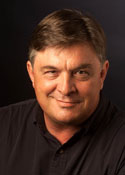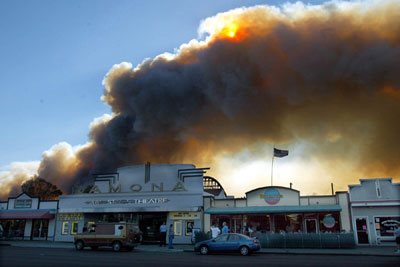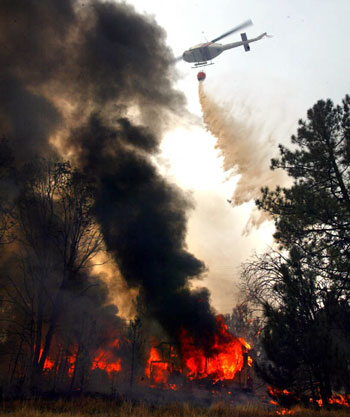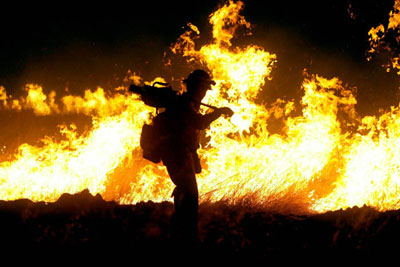 |
 |
Firestorm Déjà vu
November 2003
|
 |
||||||||||||
|
The final weeks of October 1993 were beset with unusually warm weather, almost an Indian summer, with warm winds, and low humidity. The weird weather gave birth to one of the worst wildfires in recent history. Hundreds of homes in Laguna Beach and Malibu were burnt to the ground. At the Los Angeles Times we were crafting a ten-year retrospective of the firestorms when history repeated itself. The same warm winds began to blow, and a chill ran through me as I remembered photographing block after block of burning homes ten years earlier. I was so sure of my feelings that I told Senior Photo Editor Mary Cooney that she should put out a memo warning all of the staff photographers to arm themselves with water, and to prepare their fire gear.
I found myself covering Eastern San Diego County. The fires were overwhelming. The swath of destruction spread for miles, and many of the tiny hillside communities where the homes were burning were all but impossible to reach due to downed power lines and burnt trees blocking the roads. After covering residents returning to their burnt homes in Crest, I was sent to the fire approaching the town of Julian. I attempted a late night drive down a dark stretch of highway 79 to reach the head of the fire.
The sound generated by the fire resembled the roar of a jet engine, punctuated with the booms from propane tanks exploding. It was a strange symphony that would have been interesting if it weren't so dangerous. In air thick with soot and ash, the photographic aspect of this adventure was almost secondary to just surviving the moment and living to tell about it. There were homes burning that I couldn't even get in to document. I finally turned around on Highway 79 and headed back towards Julian. Once back in the city I heard that the roads were closed in and out, the electricity was out, the townspeople were evacuated, cell phones were dead, and one pay phone in the center of town was working. After making several pictures of firefighters working an active fire line, and several others guarding the deserted town with their trucks, I moved my car into the safest place in town, the parking lot at Julian High School. I parked with the front of my car facing the burning hilltop that I had just driven back from and watched the advancing fire like a kid in a drive-in movie theater.
After 30-hours of being awake and working this fire I received the all clear and left at noon to head towards the city of Ramona, twenty-two miles and an hour of winding roads away from the nearest working cell site to send photos. Fatigued and hungry I passed through the tiny town of Wynola just after fire had crossed the road and danced around the little hamlet of cottages and homes. I began to feel safer, and the pucker factor began to leave as the smoke and devastation was getting smaller in my rear view mirror. In the safe confines of a fast food restaurant in Ramona I began to send photos back to the office in LA via my cell phone, excited about the images from the night before of firemen making their heroic stand to protect Julian. It wasn't until I was making my drive back to Orange County that I heard about firefighter Steven Rucker dying in an area that I had just been in that it all hit home. That firefighter had been killed when a freakish gust of wind blew the fire towards him as he was saving a home in an area that I had been through several hours before. In a split second, Mother Nature had spared the town of Julian, but took the life of a brave man.
I'll second that.
© Mark Boster
Los Angeles Times Staff Photographer
|
|||||||||||||
|
Write a Letter to the Editor
Join our Mailing List
© The Digital Journalist
|



